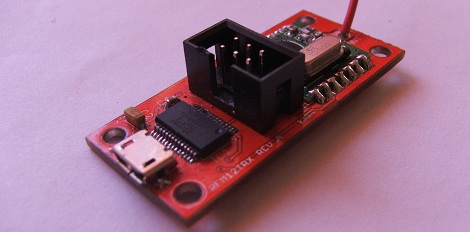In the never-ending pursuit of cheap wireless communication for your microcontroller projects, [kiu] came up with a small board that allows for serial communication via a 433MHz radio link.
[kiu]’s transceiver uses an RFM12 wireless module available online for just a few dollars. Alongside this module is an ATMega8 and a USB to serial FTDI chip. When [kiu] plugs this board into his computer, he’s able to run a terminal, connect to this board, and receive and transmit hex values at 115,200 bps from another one of these boards.
According to [kiu]’s BOM, 10 boards only cost him 180 Euros, or about $225 USD. Considering off-the-shelf solutions such as an XBee could easily cost twice as much, we’re thinking [kiu] did a very nice job here.
[kiu] put all the board files, schematics, and code up on his GitHub, ready for your perusal. A very cool build, and very useful for a high altitude balloon, rocket, or wireless sensor build.
















Pololu’s Wixel (in the USA) seems very similar and more capable (except perhaps wireless range?), and at $20 apiece… wins? http://www.pololu.com/catalog/category/91
Then I looked closer, and apparently the costs include a neat little plastic lasercut case + fasteners. Neat; and I like that he moved to micro-usb connectors (which are apparently more robust for plugging/unplugging 1000s of times)
Unfortunately, the top-mount micro-sd connectors with only a single set of mounting pads break off from the PCB extremely easily…
Correct, i will never ever reuse these micro usb sockets, they break easily.
You can easily cut the costs further by using FT230XS or XQ, around 2.50 USD per unit in quantity of 10 chips. Or, even better, any MCU with built-in USB interface, this would also make the board smaller without the second IC and ISP header.
I don’t really understand why people still use FT232 in all low speed basic UART applications.
I have almost forgotten. I also have a single TLX9E5 433 MHz radio module I bought for my next project for 18 USD from the relatively expensive store. Doesn’t have USB interface, but it’s based around 8051 compatible MCU with built in radio module and is very small. And anyone building microcontroller based devices surely has a USB to RS232/TLL cable already.
But to summarize, the overall idea of building own radio modules isn’t bad, just needs some refining, having a very low cost device nicely complements more advanced, off the shelf solutions.
The ATMega32u4 has built in USB as far as I know.
As for the radio link, I wonder how reliable and stable it is. From reviews on other sites, it seems that although this is a very cheap radio module, the range isn’t too far and it is very difficult to setup (since it requires writing your own packets and etc). Now to think about it, I might look into these. See if I can write some reliable packet based communication.
Important to note that he used 433mhz band, which is not legal in the US.
https://en.wikipedia.org/wiki/ISM_band
There is a version of the radio module he used that is 915mhz though, and that would be fine
Actually that is in the Amateur Radio spectrum. The link shows it is legal in Region 1 only. Just pay $15 and score an 80% or higher on a 35 question test to you get the license and privileges.
If in the Kansas City area, go to http://www.hamclass.org for testing and class locations.
The Nordic 2.4 GHz radios – like the nrf24L01+ or nrf24le1 (built-in 8051 CPU core) are also fun to play with. They are full featured radios with a lot of features and remove the need to manage the bitstream from the application layer.
I have no affiliation with these guys but they sell a low-cost ($15), very small module (based on the nrf24le1) that can be used for two or more way communication.
http://www.rfdigital.com/?targetpage=item&filterpn=RFD21733
What’s the cheapest, simplest, non-programmable, wireless RS-232 link?
I have a 12 year old digital projector with an RS-232 port and I want to write a remote control program for it.
All the wireless link needs to do is be able to send commands one way, there’s no comm back from the projector. The computer end can plug into RS-232 or USB.
You forgot DX $6.60 serial bluetooth modules
http://hackaday.com/2012/01/30/firmware-programmer-for-a-cheap-bluetooth-module/
There are also the fantastic wireless modules from ciseco.
http://shop.ciseco.co.uk/xrf-wireless-rf-radio-uart-rs232-serial-data-module-xbee-shape-arduino-pic-etc/
$15 USD – definitely worth a look
Also check out the TI RF2500 kit: two boards with an MCU and a 2.4 GHz radio each, plus a programmer – all for $50.
have anybody a range comparation betwen nrf24L01 and RFM12 or RFM22?
if it’s for aerial use (quadcopter) how long a 9600 bps comunication can arrive?
If you really want long range then this might be interesting:
http://www.ebay.com/itm/Wireless-FSK-transceiver-module-RFM12BP-RF-Transceiver-433-MHz-LONG-RANGE-/190715644963?pt=UK_BOI_Electrical_Components_Supplies_ET&hash=item2c6789cc23#ht_3261wt_1139
As always, when it comes to RFM12:
Use Ethersex http://www.ethersex.de
All AtMegas, RFM12, USB, Ethernet, tcp/udp v4/v6,
i2c, spi, webserver, jabber, mail, etc.
Comfortable configuration, own scripting language.
No need to code in C.
I build almost the same with the rfm70. It uses the Silabs CP2110. Take a look at it: http://www.pcmx.de/?p=158
The firmware isn’t finished now, but I’ll do it next month
i didn’t hear anything nice about the RFM12, quite complicated to set-up and a huge amount of error correction is needed because you get broken packets all the time..